Speciality of Benin (Dahomey): Benin is a West African country between Nigeria and Togo. It is shaped by the legacy of the Dahomey kingdom. This kingdom was once very powerful.
Today, Benin’s culture is deeply connected to Vodun, or Voodoo. This spiritual practice is very important in Benin. The country’s traditions, music, and art show its roots in the Dahomey civilization.
The Dahomey kingdom was known for its all-female Amazon warriors. This shows its unique history. Now, places like Cotonou’s markets and museums are popular with visitors.
Artists like Angélique Kidjo and dishes like akara celebrate Benin’s heritage. It’s a living celebration of its past.
Key Takeaways
- Benin’s spiritual practices like Vodun define its cultural traditions and global recognition.
- The Dahomey kingdom’s military legacy includes the Amazon warriors, a symbol of historical strength.
- Benin culture thrives through music icons like Angélique Kidjo and festivals that draw international attention.
- Cotonou’s markets and historic sites rank among the Best travel destinations for cultural exploration.
- Unique features of Benin include its mix of ancestral beliefs, artistic crafts, and historical landmarks like former Dahomey capitals.
A Brief History of Benin (Dahomey)
Benin’s history is tied to the Kingdom of Dahomey. This kingdom was a big deal in West Africa. It started in the 1600s and became known for its smart military and government.
The name Dan-ho-me comes from a burial site of a defeated king. It shows the kingdom’s roots.
The Kingdom of Dahomey
The kingdom’s army was famous, especially the Mino women warriors. They showed the kingdom’s special way of seeing gender. By the 1800s, Dahomey moved from slave trade to palm oil, fitting into global markets.
In the 1890s, France took over and named it “Dahomey.” It became part of French West Africa.
Today, Benin’s traditions live on at UNESCO sites like the Royal Palaces of Abomey. These places tell stories of the kingdom’s history. They are key for anyone wanting to see the historical significance of Dahomey.
Travelers often go between November and February. This is the dry season, perfect for visiting.
- Founded c. 1600, Dahomey became a regional power by the 18th century.
- Its military prowess included 6,000 trained Mino soldiers by the 1890s.
- Colonial rule ended in 1960, but its legacy persists in Benin’s cultural identity.
At the Abomey Historical Museum, you can see artifacts and hear stories. It brings Benin’s history to life. It mixes Speciality of Benin traditions with today’s travel.
A Brief History of Benin (Dahomey)
The French ruled Dahomey from 1894 to 1960. This time shaped Benin’s identity. Cities like Cotonou and Porto-Novo show this with big buildings and French language.
Schools and laws followed European ways but kept local traditions. This mix is still seen today.
“The French left a visible mark on Benin’s urban landscapes,” says a cultural expert.
Planning a trip to Benin? Look for safe places to visit. Most areas are safe, but check travel advisories first.
In Cotonou, you can stay in old hotels or try eco-lamps in parks. Don’t miss Ouidah’s slave route or Abomey’s royal palaces for history tours.
- Where to stay in coastal areas: Colonial-era hotels or eco-lamps in the north
- Hidden spots: Ouidah’s slave route or the Danxoméme palace ruins
Planning a trip to Benin means seeing cultural sites like Grand Popo and natural wonders like Pendjari National Park. Benin’s mix of history and adventure makes for a special trip.
A Brief History of Benin (Dahomey)
Benin became free from France in 1960. It then changed its name to the Republic of Benin in 1990. It started to be a travel destination with solo travel ideas, luxury travel experiences, and adventure travel.
Cotonou is a safe place for solo travelers. Pendjari National Park in the northwest is great for wildlife adventures.
“10 gunmen, 1 soldier killed in northern Benin attack • Mar. 2, 2025, 8:39 AM ET (VOA – Voice of America English News)”
| Region | Description |
|---|---|
| Coastal Region | Flat, sandy terrain with lagoons ideal for beach family vacation spots. |
| Atakora Mountains | Peaks up to 2,103 feet, perfect for hiking and cultural tours. |
| Pendjari National Park | Wildlife-rich savannas for safari-style adventure travel. |
Benin mixes old traditions with new ways. You can find luxury travel experiences in Ouidah and UNESCO sites. Solo travelers can explore the Atakora Mountains.
Families love the beaches near Grand Popo. They also visit voodoo shrines. Travel guides say major tourist areas are safe and easy to get to.
Benin is getting more stable, thanks to deals like the $50m GHIB-BII trade deal. You can see five natural areas, from lagoons to mountains. Benin’s travel guide helps you find what you want to see.
Rich Cultural Traditions
Benin traditions shine through lively festivals. These events mix spirituality, art, and community. You’ll see music, dance, and rituals that show the nation’s heart.
Exploring Ouidah’s Vodun Festival or watching the Gelede masquerade is special. Each celebration shares stories of heritage and strength.
Festivals and Celebrations
| Festival | Date | Highlight |
|---|---|---|
| Vodun Festival | January 10 | Honors ancestral spirits with music, dance, and ritual offerings. |
| Gelede Masquerade | Varies by region | Masked dances celebrate women’s roles in society with intricate costumes. |
| Nonvitcha Festival | November | Showcases Betammaribe culture with wrestling matches and traditional dances. |
Planning your trip? Make a travel packing list with clothes you can breathe in, sunscreen, and a journal. For saving money, stay in local places and join tours. Learning Fon or Yoruba phrases helps you connect with people.
- Visa requirements for U.S. citizens: Get an e-visa online with a valid passport, yellow fever certificate, and return ticket.
- Respect cultural norms: Dress modestly (covered shoulders/knees) during ceremonies.
Benin’s festivals are more than just events. They are a part of the nation’s culture. Enjoying akara at markets or dancing to drums lets you see history come alive.
Rich Cultural Traditions
Traditional music and dance in Benin are very important. They tell stories of history and spirituality. The Benin art scene uses instruments like talking drums and kora. These sounds are heard during festivals like the Voodoo ceremonies in Ouidah.
Visitors can see these traditions at cultural centers in Cotonou and Porto-Novo. Here, ensembles perform dances. You can see the Fon people’s drumming or the Bariba’s melodies. Don’t forget to get Best travel insurance before going to remote places.
- Enjoy affordable public transport in Benin via shared “taxis-brousse” or motorcycle taxis (“zemidjans”).
- How to save money while traveling: Use local buses and eat at street markets for real meals.
- Beware of travel scams to avoid, like unsolicited guides claiming exclusive access to sacred sites.
“Benin’s rhythms are the heartbeat of its soul,” says UNESCO, recognizing the heritage status of Vodun rituals.
Legendary artists like Angélique Kidjo share these sounds worldwide. She mixes tradition with modern beats. Music and dance in Benin connect us to its deep cultural legacy.
Rich Cultural Traditions
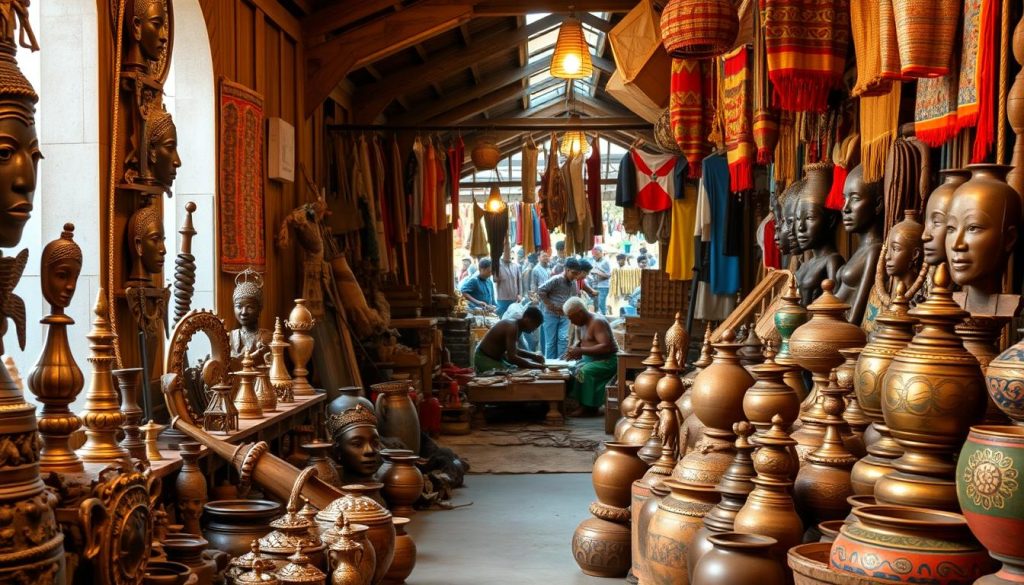
Benin’s art is amazing, thanks to Dahomey artifacts and colorful crafts. It mixes history with creativity. You can see Hidden gem destinations where artists keep old ways alive.
These spots make art a big part of Things to do in Benin. You’ll see culture in every stroke of paint and every carving.
Artistic Expressions
In places like Abomey, you’ll find royal bronze plaques. The Yoruba’s guelede masks tell stories of kings and spirits. Eco-friendly travel lets you meet artisans in villages near Cotonou.
They make pottery with methods that haven’t changed for years. Places like the Abomey museum and Porto-Novo’s workshops are full of culture.
| Destination | Art Forms | Location |
|---|---|---|
| Abomey Historical Museum | Bronze plaques, royal regalia | Abomey |
| Porto-Novo Craft Centers | Appliqué tapestries, wood carvings | Porto-Novo |
| Parakou Open-Air Museum | Traditional textiles, nature-inspired sculptures | Parakou |
In villages near Ouidah, artists make masks and jewelry from recycled stuff. This fits with Eco-friendly travel. They welcome visitors to learn old skills.
Visiting markets in Cotonou or museums, you’ll feel Benin’s art. It connects you to its past and present.
Unique Cuisine of Benin
Benin’s food scene is full of flavors from its rich land. The best time to visit is November to January. This is when markets like Cotonou’s Grand Marché de Dantokpa are full of fresh food.
When planning your itinerary, check out these markets. Staying in Abomey or Cotonou makes it easy to find local food. Family-run “maquis” offer dishes not found in tourist spots.
Staple Ingredients
- Yams: Steamed or mashed into pounded yam, often paired with savory apon sauce.
- Cassava: Ground into gari, a versatile dried staple.
- Locust beans: Used to make soumbala, a pungent seasoning.
Try akara (bean cakes) and ato (plantain fritters) for a taste of Benin. Restaurants like Restaurant Le Bénin and Chez Maman serve these dishes. Exploring hidden spots lets you taste family recipes, showing Benin’s food is a journey through culture.
Unique Cuisine of Benin
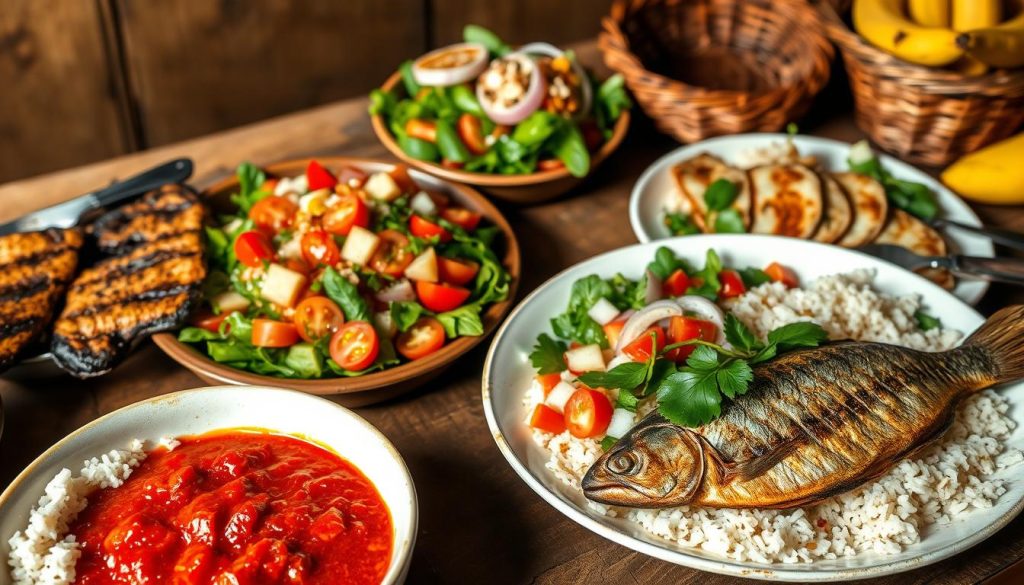
Benin’s food scene is full of bold flavors. It mixes African, French, and Brazilian tastes. You can find tasty dishes at street stalls and fancy restaurants alike.
- Kuli-kuli: Spicy peanut snacks perfect for on-the-go adventures
- Akara: Savory bean fritters found at markets
- Calalou: Seafood and okra stew showcasing local ingredients
- Tchakpalo: Fermented millet cake from northern regions
“Exploring Benin’s food is a must for any Adventure travel enthusiast—it’s like a flavor journey through history.”
For Solo travel ideas, try Wagasi (soft cheese) in the north or sample Akassa (fried fish) along the coast. Travel guides often highlight pounded yam with rich sauces like sauce d’arachide. Don’t miss Feijoada, a Brazilian-inspired dish with local fish. Benin’s food is a taste of its rich heritage, whether in markets or luxury hotels.
Unique Cuisine of Benin
Benin’s food is made special by simple ingredients. They ferment grains and make tasty sauces. Visitors can take notes on recipes with a travel packing list notebook.
Culinary Techniques
They use slow cooking in clay pots and fermentation. These methods make dishes like akara and dadawa stand out. Key techniques include:
- Fermentation: Makes staples like gari and dadawa from maize, cassava, and locust beans.
- Smoking: Preserves fish and meats, common in coastal areas.
- Palm Oil Production: A hard process that makes the bright oil used in many dishes.
| Technique | Example Dish |
|---|---|
| Fermentation | Akassa (fried fermented corn dough) |
| Smoking | Grilled smoked fish |
| Palm Oil Use | Thickness in sauce dishes |
For travelers, budget travel tips include visiting local markets. Watch techniques live. Use travel hacks for food adventures like learning French. Check visa requirements for Benin through their e-visa system before you go. Don’t forget best travel insurance for foodborne illness risks.
Try these methods at Restaurant Le Bénin or Chez Maman. Chefs there show off old methods. It’s great for those who love to try new things!
Diverse Languages Spoken
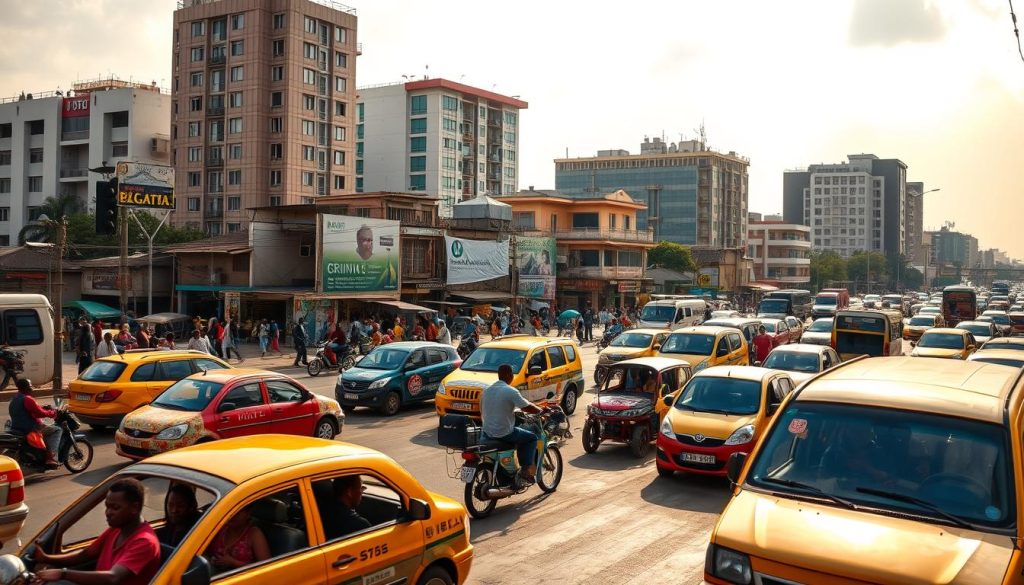
Planning a trip to Benin? Knowing French is very important. It’s the official language used in government, schools, and public transport. Travel guides say French is key for daily life, helping budget travelers.
Learning basic French phrases helps avoid scams. It also makes moving around markets or bus stations easier.
French as the Official Language
French’s role comes from Benin’s colonial past. It shapes road signs and radio programs. Knowing French helps save money by asking for prices in it.
Public transport signs and schedules are in French. Learning basic directions in French avoids getting lost.
- Use French to negotiate fares on local buses.
- Watch for scams like fake guides claiming to offer “free English lessons” to trap tourists.
- Listen to radio broadcasts mixing French and local dialects to blend in.
“Language bridges culture and safety. Knowing French keeps travelers informed and safe.”
How to plan a trip to Benin? Start with French basics. Roadside signs and market negotiations rely on it. Avoid scams by confirming prices aloud in French to prevent overcharging.
Local dialects are common outside cities. But French is the key for travel guides and important interactions.
Diverse Languages Spoken
Benin has over 55 local dialects, with French as the official language. From Parakou’s markets to the Atakora highlands, language is key. Hidden gem destinations like Betammaribe villages show tonal dialects alive today.
Local Dialects and Languages
Some important dialects are:
- Fon: Spoken by 3 million+ in southern regions
- Yoruba: Common in the southwest near Nigeria
- Betammaribe: Tonal language of the Atakora’s Tamberma people
Travelers can do many things in Benin’s rural areas. For example:
- Join Fon-language storytelling sessions in Ouidah
- Listening to traditional songs in Dendi at Lake Nokoué
The top places to visit for language immersion are:
- The Grand Marché in Parakou, where traders speak Bariba and Mina
- The Gelede Festival in March, where Yoruba songs revive traditions
These tourist attractions show how language ties to art, food, and life.
Radio stations like Radio Presse play local dialects. They offer a free audio journey through Benin’s verbal arts. Exploring these sounds and sights helps us understand this West African crossroads better.
Diverse Languages Spoken
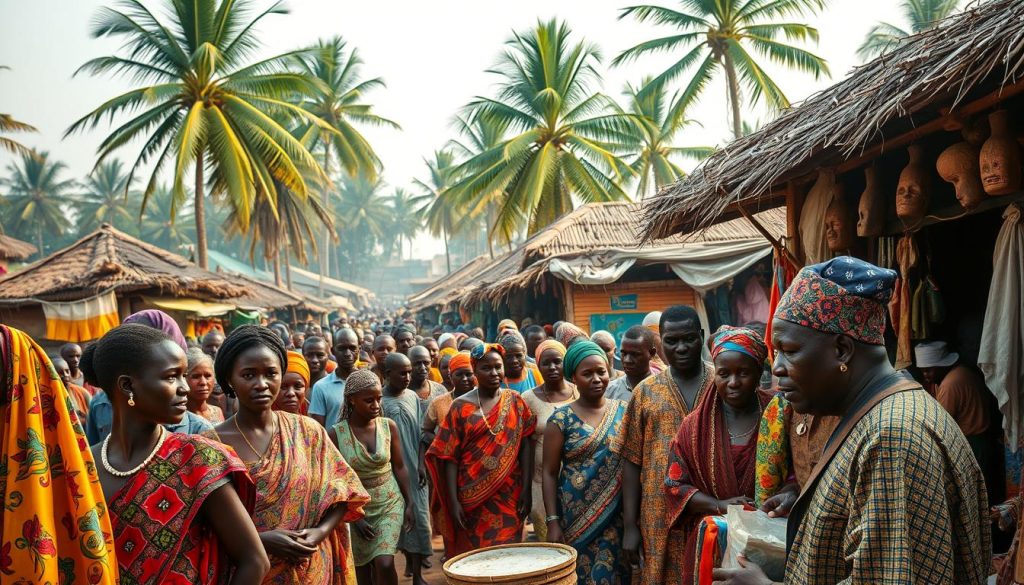
Language in Benin is more than words. It connects us to history, spirituality, and community. Indigenous tongues like Yoruba carry stories and knowledge lost in translation. For travelers, understanding this link makes every eco-friendly travel experience richer.
The Importance of Language in Culture
Yoruba’s dialects show Benin’s cultural diversity. But, many young people talk in French, risking their heritage. To truly connect, travelers should:
- Visit hidden spots like Nikki’s Bariba cultural centers in their itinerary.
- Stay in Abomey places that hire locals who speak French and native dialects.
- Learn basic phrases like “A pepe” (hello in Fon) to build trust and feel safe in remote areas.
Language is at the heart of Benin. Eco-friendly travel companies work with griots to teach about local terms and rituals. This helps protect both nature and language. Travelers’ curiosity about language uncovers Benin’s identity, from naming ceremonies to oral histories. Saving these voices ensures traditions live on for future generations.
Traditional Attire and Textiles
Benin’s Traditional attire of Benin shows centuries of art and culture. Bright tapestries and fabrics are key in ceremonies. They tell stories of history and identity. For travelers, seeing these crafts makes any trip to Benin richer. A good Travel guide will show you where to find these traditions.
The Art of Appliquéd Textiles
Yoruba artisans are masters of dyeing and beadwork. They make special clothes for important life events. Colors mean a lot: indigo for spirit, red for safety, and gold for kings.
Visitors can see these crafts at family-friendly spots like Abomey villages. Here, weaving demos are fun for everyone. For solo travelers, Cotonou cooperatives offer private lessons in dyeing or embroidery.
- Abomey Museum displays historic royal tapestries
- Cotonou markets sell authentic handwoven fabrics
- Weekend tours to weaving cooperatives
Today, designers mix these textiles with modern styles. This shows how traditions grow. When you visit Benin, every Traditional attire of Benin piece tells a story.
Traditional Attire and Textiles
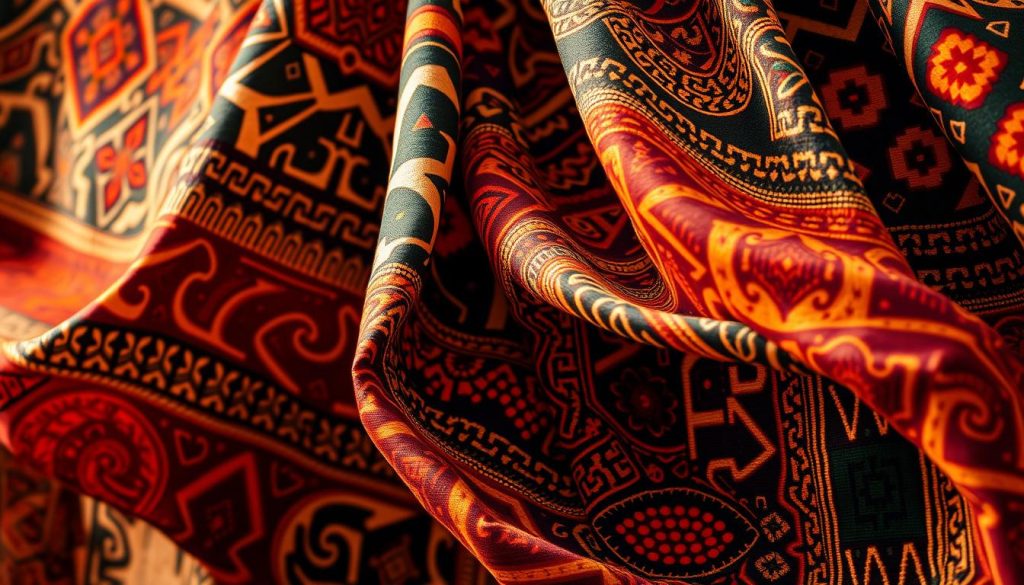
Benin’s traditional clothes show its many ethnic groups and local traditions. You’ll see grand boubou and wrappers, but also pagne and agbada. These clothes mean a lot to the culture.
In northern villages, the Somba people wear simple clothes. But in southern markets, you’ll find bright Ankara prints. Ceremonial masks and beaded headdresses add to the traditions.
Wearing local clothes makes your trip better. In Cotonou, tailors make custom clothes from hand-dyed fabrics. A good packing list includes clothes to match what you buy.
For cheap fabrics, try the Grand Marché. To get your clothes made, bring pictures of what you want. These clothes tell stories of Benin’s past.
- Try a gele headwrap for festivals—easily styled with help from local vendors.
- Look for mud-cloth (bogolan) from Dogon regions as a unique souvenir.
- Ask tailors about symbolic patterns like the Adinkra symbols from Akan communities.
Wearing traditional clothes shows respect for Benin’s history. It makes your trip more special and unforgettable.
Traditional Attire and Textiles
Benin’s fashion world blends old skills with new styles. In Cotonou and Porto-Novo, designers make old techniques like Yoruba adire dyeing into cool modern clothes or accessories. This way, they keep traditions alive while also meeting today’s fashion needs.
| Traditional Techniques | Modern Applications |
|---|---|
| Adire resist-dye | Ethnic patterns on tailored suits |
| Kente-inspired weaving | Textured fabrics in streetwear |
| Beadwork | Statement jewelry for runway collections |
When visiting Benin’s fashion spots, check visa requirements for events like Cotonou Fashion Week. If you buy expensive items, get best travel insurance to protect them. To save money while traveling, go during off-peak times for cheaper deals. Watch out for travel scams to avoid, like too-high prices from fake sellers. Use public transport in cities, but take private cars when you have valuable things.
“Social media turns Benin’s textiles into global trends overnight,” says a local designer, noting Instagram’s role in showcasing fusion styles.
Travelers can enjoy both culture and fashion by respecting traditions and trying new things. Stay informed and enjoy the adventure!
Wildlife and Natural Wonders
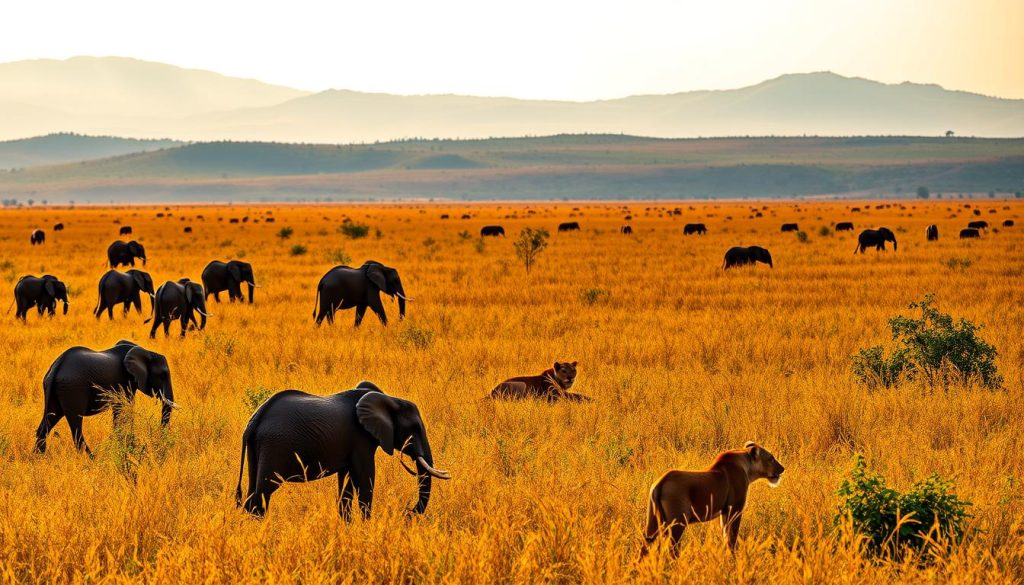
Benin is full of unique features beyond its culture. It has natural landscapes like savannas and wetlands. These areas are home to many animals.
Pendjari National Park is a UNESCO Biosphere Reserve. It’s a great place to see lions, elephants, and hippos. Nearby, W National Park is shared with Niger and Burkina Faso. It offers wildlife safaris.
The Lama Forest Reserve protects ancient forests. These forests are very special.
“The Fon people see nature as sacred. Rivers, trees, and even cowrie shells are orishas—spirits guiding harmony between humans and the wild.”
Explore hidden spots like the waterfalls of the Atakora region. Or visit the floating villages of Lake Nokoué. The Sitatunga Vallée is great for seeing rare antelopes in wetlands.
When you plan your travel guide, visit during the dry season (November–March). This is when you can see more wildlife.
- Is safe to visit? Parks need licensed guides for safety. Use trusted tour operators for updates.
- How to plan a trip to Benin’s parks: Book tours early, bring sunscreen, and respect local traditions.
Benin’s natural beauty is linked to its culture. From cowrie shells in rituals to protected forests, each place has a story. Don’t miss these unique features that make Benin’s wilderness unforgettable.
Wildlife and Natural Wonders
Benin’s wild landscapes offer eco-friendly travel adventures. You can find hidden corners where nature thrives. Places like the Massif of Dan and Lake Nokoué are full of rare species and ancient ecosystems.
From tracking hippos in the Mono River to spotting butterflies in the Lama Forest, things to do in Benin’s wild spaces are unmatched.
| Top Places to Visit | Wildlife Highlights | Best Time to Visit |
|---|---|---|
| Pendjari National Park | African elephants, lions, and antelope | November–February (dry season) |
| Massif of Dan | Endemic plants and forest primates | December–March (dry season clarity) |
| Ouémé River Valley | Red-bellied monkeys, medicinal plants | Year-round for guided tours |
For eco-friendly travel, the best time to visit depends on what you like. Dry seasons (November–February) are best for seeing animals clearly. Wet months show off the plants in bloom.
Visitors can explore baobab groves or join guides in sacred forests. Here, traditional knowledge helps protect nature. Keeping these places safe makes Benin a living museum of nature’s wonders.
Wildlife and Natural Wonders
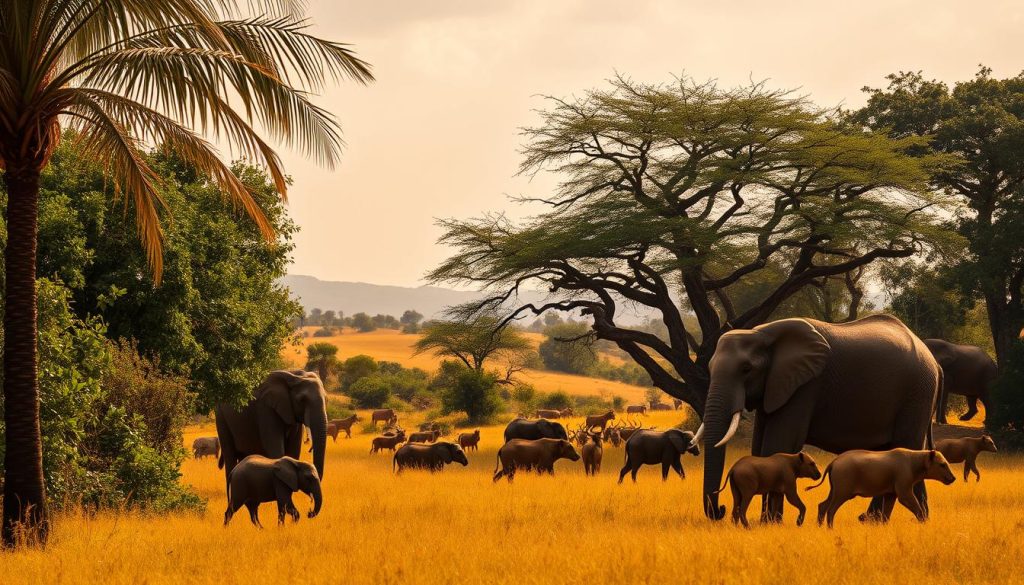
Benin’s wild places are kept alive by mixing old wisdom with new science. This mix creates tourist attractions for visitors. They get to see the beauty of the country while helping to save it.
Conservation Efforts
Places like Pendjari National Park need help from both governments and local people. Eco-lodges near W National Park help protect habitats. Guests can go on adventure travel tours or help plant trees in wetlands.
- Join guided hikes with ex-hunters in Gnanhouizounmè Forest.
- Monitor sea turtles at Lake Nokoué during nesting seasons.
- Choose solar-powered lodges to reduce environmental impact.
| Location | Conservation Role | Visitor Options |
|---|---|---|
| Pendjari National Park | Lion and elephant protection | Safaris with researchers |
| Lake Nokoué | Mangrove restoration | Turtle nesting tours |
| Atakora Mountains | Forest biodiversity | Guided hikes |
Make a plan that includes eco-tours and cultural visits. Many lodges work with hidden spots like the Sitatunga wetlands. Here, you can see rare antelopes in their new home. Every visit helps keep Benin’s nature safe for the future.
Economic Specialties
Agriculture is key in Benin’s economy, thanks to the Dahomey civilization‘s farming ways. Cotton is a big export, making Benin important in West Africa’s textile world. Pineapples, cashews, and palm oil also add to exports.
Small farms grow yams, cassava, and maize for locals. This shows how farming has changed but stayed diverse.
Agriculture and Exports
Modern issues like climate changes and price ups are big challenges. They show why Best travel insurance is important for those visiting rural Benin. It helps get medical help in far places.
Travelers can save money while traveling by going to markets like Bohicon’s Thursday bazaar. Here, fresh food is cheaper. But, watch out for travel scams to avoid. Some “farm tours” might cost more for fake experiences.
- Exports: Cotton, pineapples, cashews, palm oil
- Local staples: Cassava, yams, maize
- Initiatives: Organic cotton certifications and cashew processing plants aim to boost incomes.
Getting around villages often means using public transport in Benin. Bush taxis are cheap but can be full. New storage and crops help farmers, keeping traditions alive while growing.
Economic Specialties
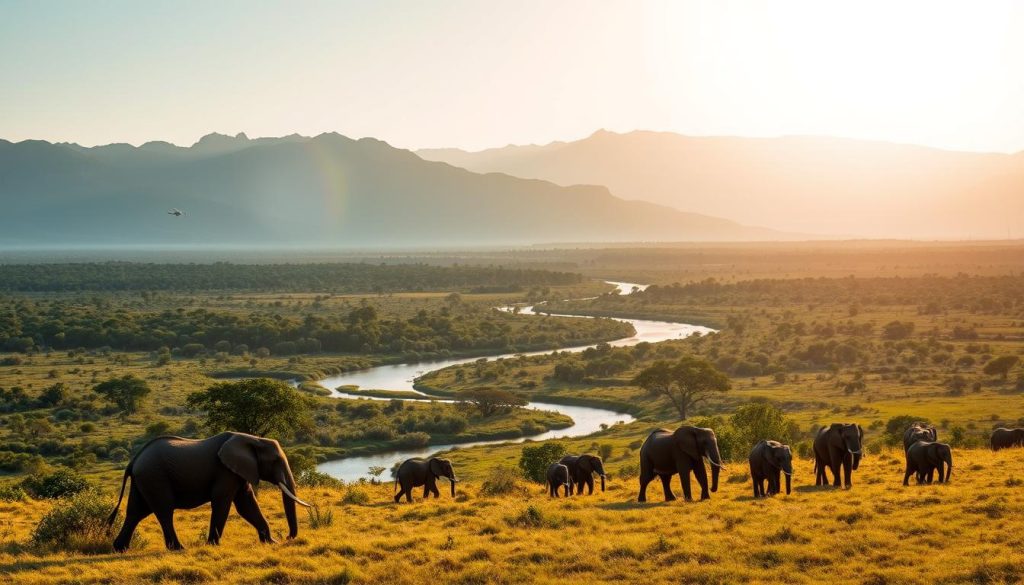
Benin’s tourism helps its economy grow. People visit historic sites and natural wonders. This supports local communities and helps the country grow.
Places like the Route des Esclaves in Ouidah and the royal palaces of Abomey attract history lovers. Families and adventure seekers find cultural landmarks and eco-tours.
Tourism Industry
Planning a trip often begins in Cotonou. Then, visitors go to Ouidah’s Door of No Return or Pendjari National Park. Hidden spots like the Taneka villages offer unique cultural experiences.
For families, places like Ganvié’s stilt village or the Python Temple are unforgettable. Benin is a great place for family vacations. There are many places to stay, from luxury hotels to eco-lodges.
Visitors can see museums in Porto-Novo and Parakou. Many stay in restored colonial homes or guesthouses run by locals. This supports the local economy. Even with better infrastructure, some areas keep their authentic charm.
- Must-see sites: Route des Esclaves, Abomey palaces, Ganvié village
- Stay options: From boutique hotels to eco-lodges
- Hidden gems: Togolese border markets and northern villages
“Benin’s blend of history and nature makes every journey unforgettable,” says a local guide. “Visitors leave with stories and a deeper cultural connection.”
Economic Specialties
Benin’s economy grows thanks to Dahomey artifacts and handmade items. These items mix old traditions with new trade ways. Artisans keep up old skills, making things that show off culture and help people earn money.
Craftsmanship and Artisanal Products
In Abomey, artists still make Dahomey artifacts like bronze statues the old way. They use a lost-wax method to make these items. These pieces show the kingdom’s history.
The Traditional attire of Benin, like tapestries, tell stories of kings and history. They are made by experts in Covè and Abomey.
| Region | Craft | Products |
|---|---|---|
| Abomey | Bronze casting | Ritual statues |
| Somba | Pottery | Decorative vessels |
| Covè | Basketry | Handwoven textiles |
Luxury trips let people watch bronze-casting or make Traditional attire of Benin in workshops. Adventure travel paths take visitors to places like Somba’s pottery areas. Solo travel ideas include paths from Cotonou’s market to craft villages.
- Bronze casting demonstrations in Abomey
- Appliqué textile workshops
- Pottery villages tours
These crafts also sell to designers all over the world. Women run many groups, making money from their skills. From village studios to city markets, Benin’s artists keep traditions alive and help the local economy.
The Role of Religion
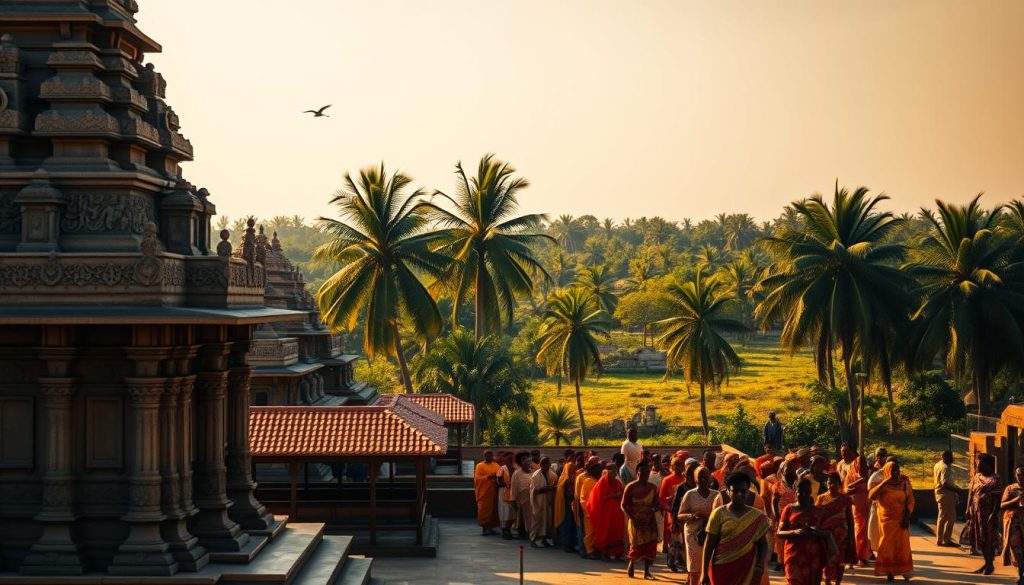
Traditional beliefs in Benin are still strong. They mix old ways with today’s life. In the south, animist traditions are common. In the north, Islam has a big impact.
Vodun is a big part of Benin. It honors a high god through spirits and nature. It’s different from what many people think.
- Solo travel ideas include tours of the Sacred Forest of Kpasse. Here, people honor their ancestors in special groves.
- Family vacation spots like Ouidah’s Temple of Pythons teach about snakes. They show how snakes protect us spiritually.
- For luxury travel experiences, you can have private divination sessions. Local priests use cowrie shells to show Yoruba beliefs.
- Adventure travel fans can explore the Atakora Mountains. Here, Betammaribe people do rituals tied to the stars.
Benin’s religious ways are alive today. The Vodun Festival in January brings people together. It shows the area’s spiritual strength.
Travel guides say these places are key to seeing Benin’s heart. They ask visitors to be respectful when they explore these sacred areas.
The Role of Religion
Benin’s religious scene is a mix of old traditions and new faiths. You’ll find Christianity, Islam, Vodun, and blends of these in daily life. The north is mostly Muslim, while the south is Christian and Vodun.
Vodun focuses on ancestors and nature. Many families mix their beliefs over time.
“The Yoruba’s traditional religion includes 400 deities, yet many followers today mix these beliefs with Christianity or Islam,” highlighting Benin’s adaptive spirituality.
When visiting religious sites, remember to pack right. You’ll need clothes that cover your shoulders and knees. For budget travel tips, visiting places like Abomey’s Royal Palaces or Ouidah’s Temple of Pythons is free. You can give what you want.
Travel hacks for being respectful include removing your shoes and asking before taking pictures. Make sure to check visa requirements for Benin tourism online. Some festivals might need you to stay longer. Get best travel insurance for areas where medical help is hard to find.
- Islam came through the Sahara Desert, affecting northern groups like the Fulani.
- Christianity came with 19th-century missionaries in the south.
- Vodun is still strong, with rituals honoring ancestors key to Benin’s identity.
This mix shows Benin’s history, where different faiths live together. Exploring with respect lets you see how spirituality and tradition are one in Benin.
The Role of Religion
Benin’s festivals and rituals are full of music, dance, and art. They celebrate the community. The Vodun Festival in Ouidah honors ancestral spirits. The Gelede masquerades of the Yoruba people are also special.
These events are part of daily life. They guide harvests and honor ancestors.
Festivals and Religious Ceremonies
Big events like the January 10 Vodun Festival and Gelede performances attract visitors. Easter processions in the south and Eid celebrations in Muslim areas show Benin’s diversity. To enjoy these, travelers need to plan well:
- How to plan a trip to Benin during festivals means checking dates. Many events follow the seasons.
- How to save money while traveling means booking hotels early. This avoids high prices later.
- Public transport in Benin might be slow during festivals. Get there early.
- Travel scams to avoid include fake “VIP access” sellers. Use official guides instead.
- Eco-friendly travel means using reusable bottles. This helps at crowded events.
Many ceremonies honor ancestors, like the Fon people’s vodun. This inspired Haitian voodoo. Be respectful, like not taking pictures of sacred things without asking. Joining a Gelede dance or a harvest celebration gives deep cultural insights.
Tourism Attractions in Benin
Benin’s historical sites are tourist attractions that take you back in time. You’ll see the African royalty, colonialism, and the people’s strength. The Top places to visit include UNESCO-listed sites like the earthen palaces of Abomey. Here, 12 Dahomey kings ruled.
Nearby, the haunting Route des Esclaves in Ouidah shows the slave trade’s path. It’s marked by the Door of No Return. These sites make Benin a hidden gem destinations for history lovers.
- Abomey’s Royal Palaces (UNESCO World Heritage)
- Route des Esclaves memorial trail
- Ouidah’s Historical Museum in a Portuguese fort
- Parakou’s Open-Air Museum showcasing northern cultures
“Walking through Abomey’s courtyards, you hear the echoes of a kingdom that shaped West Africa’s history.”
For Things to do in historical zones, take guided tours. They tell stories of carved pillars and throne rooms. Reenactments at festivals bring traditions to life.
The best time to visit is November to March. This avoids rainy season floods. Don’t miss Porto-Nono’s Honmè Palace or the fortified Somba villages in Atakora.
Visit colonial-era buildings in Grand-Popo and explore sacred forests. These sites mix Benin’s past into memorable travel experiences.
Tourism Attractions in Benin
Benin has five different regions, each with its own beauty. You can see the Atlantic coast and the Atakora Mountains. Pendjari National Park is a top spot for animal lovers, with elephants and lions.
Planning a trip or looking for secret spots? Benin’s nature is full of adventures and discoveries.
Natural Attractions
Pendjari National Park is great for seeing animals. You can stay in eco-lodges or guesthouses run by local communities. There, you can go on game drives or hikes to find water.
The Atakora Mountains have trails for hiking. The forests by the Mono River are home to monkeys and rare birds.
- Hidden Spots: Lama Forest Reserve has old forests. Grand-Popo’s lagoons are good for bird watching.
- Adventure Travel: You can go canoeing in Lake Nokoué or trek in the Atakoras. It’s a mix of culture and nature.
- Wildlife: The Taneka highlands and Atakora’s waterfalls are beautiful.
Is it safe to visit these places? Most parks have strict rules for safety. Rangers help keep visitors safe. Exploring Pendjari or the Niger River’s wetlands is safe and fun.
Tourism Attractions in Benin
Exploring Benin shows the heart of a nation rich in history. You can dive into Benin traditions through music, dance, and rituals. These are linked to the Dahomey kingdom’s past.
The Unique features of Benin are seen in places like Abomey. Here, the Historical Museum of Abomey shows royal items from the old kingdom. For U.S. travelers, getting an e-visa is easy online. You just need your passport and proof of travel plans.
Getting Best travel insurance with medical coverage is smart. It helps when you join cultural events far from home. You can see Zangbeto masquerades or learn to drum in Ouidah.
The Ethnology Museum in Abomey has appliquéd tapestries from the Dahomey kingdom. The French Cultural Centre in Cotonou mixes modern art with old traditions.
Benin traditions are alive every day. Watch potters in Savalou or join Vodun ceremonies in Grand-Popo. The Dahomey kingdom’s homes and Parakou’s markets show Benin’s past and present. Visit What Is The Specialty of to Explore more interesting countries facts and places to visit worldwide.
